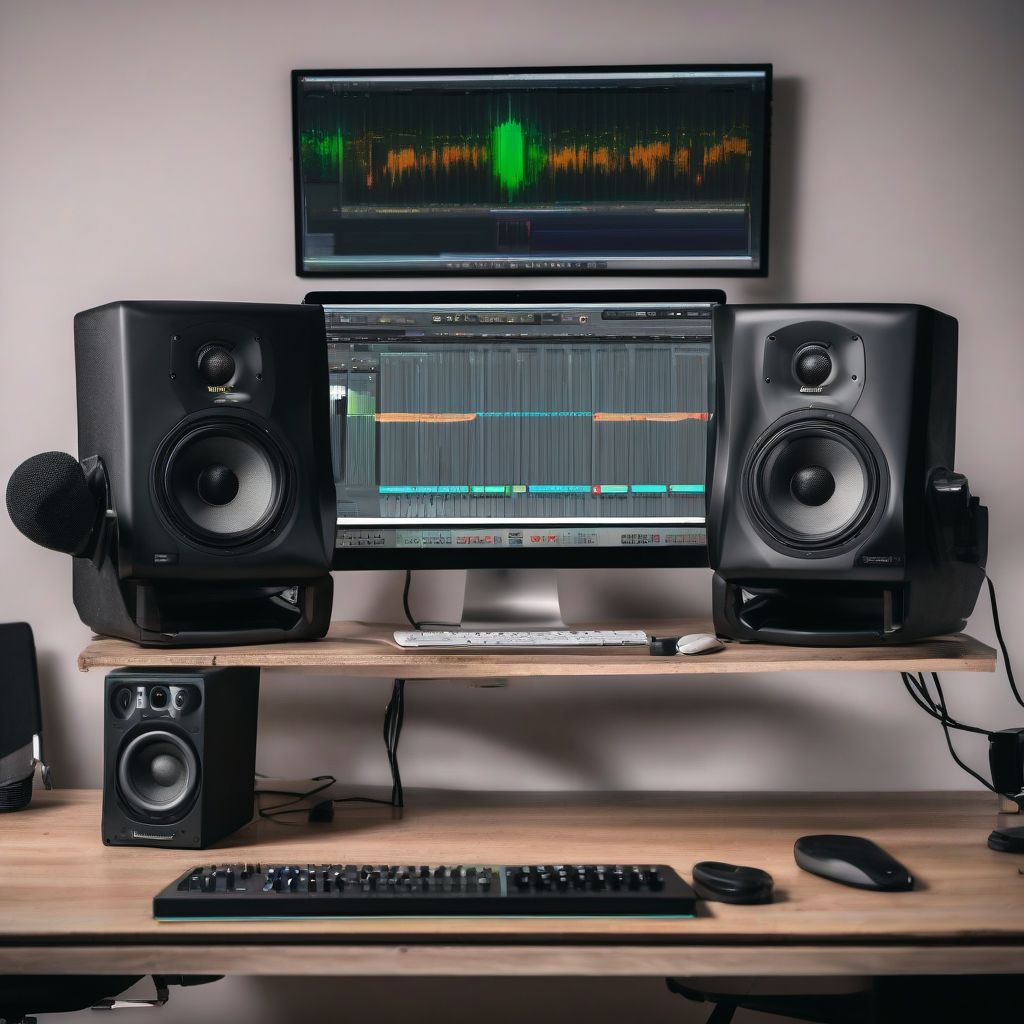“Garbage in, garbage out.” You’ve probably heard this phrase thrown around in the music production world, and for good reason. It highlights a fundamental truth: the quality of your audio equipment directly impacts the quality of your final mix. And when it comes to achieving accurate sound, nothing is more crucial than a good pair of studio monitors.
But what makes studio monitors so special? Why not just use any old pair of speakers or headphones?
 Studio Monitors for Accurate Sound
Studio Monitors for Accurate Sound
Understanding the Importance of Accurate Sound Reproduction
Imagine this: you’re crafting a delicious meal. You carefully select the freshest ingredients, measure them meticulously, and follow your recipe to the letter. Now, imagine serving that masterpiece on paper plates. Sure, it might fill you up, but the experience just wouldn’t be the same, would it?
That’s essentially what it’s like mixing on the wrong speakers. Your studio monitors are your sonic plateware. They are the vessels through which you experience your music in its purest form. Without a neutral and accurate representation of your audio, you’re essentially mixing blindfolded, making decisions based on guesswork rather than true sonic information.
Studio monitors are engineered for precision. Unlike consumer speakers designed to color the sound and make it more “pleasing,” studio monitors prioritize clarity and neutrality above all else. This allows you to:
- Hear flaws you might otherwise miss: Subtle pops, clicks, harsh frequencies, and phase issues become glaringly obvious on good studio monitors.
- Make informed mixing decisions: When you trust what you hear, you can confidently adjust EQ, compression, panning, and other effects with accuracy.
- Ensure your mix translates well: What sounds good on your monitors has a higher chance of sounding good on other playback systems.
Key Features of Studio Monitors
Not all studio monitors are created equal. Here are some essential features to consider when choosing the right pair for your needs:
1. Frequency Response
This refers to the range of frequencies a speaker can reproduce accurately. Look for monitors with a wide and flat frequency response, typically from 50Hz to 20kHz, to ensure you’re hearing all the lows, mids, and highs in your mix.
2. Drivers
Drivers are the components responsible for producing sound. Most studio monitors utilize a two-way design, consisting of a:
- Woofer: Handles the lower frequencies (bass and lower midrange)
- Tweeter: Reproduces the higher frequencies (treble)
Larger woofers generally produce deeper bass, while tweeters come in various designs, each with its own sonic characteristics.
3. Amplification
Studio monitors can be either:
- Active: Have built-in amplifiers, offering a convenient all-in-one solution.
- Passive: Require an external amplifier, providing more flexibility in tailoring your sound.
4. Room Acoustics
Even the best studio monitors can be hindered by poor room acoustics. Consider investing in acoustic treatment like bass traps, diffusers, and absorbers to minimize reflections and create a more controlled listening environment.
The Benefits of Investing in High-Quality Studio Monitors
Think of high-quality studio monitors as an investment in your craft. Here’s how they can benefit your music production journey:
- Improved Mix Quality: Accurate monitoring leads to better mixing decisions, resulting in cleaner, more polished, and professional-sounding tracks.
- Increased Confidence: When you trust your monitoring system, you can mix with greater confidence and conviction, knowing your artistic vision is being translated faithfully.
- Time-Saving: Spotting and fixing issues early on saves you time and frustration in the long run.
- Enhanced Creativity: With a clear and transparent sonic picture, you can focus on the creative aspects of music production without being bogged down by technical limitations.
Choosing the Right Studio Monitors
Selecting the right studio monitors is a personal decision. Consider the following factors:
- Budget: Studio monitors range in price from a few hundred dollars to several thousands.
- Room Size: Larger rooms generally require larger monitors to fill the space with sound adequately.
- Music Genre: Different genres may benefit from monitors with specific sonic characteristics.
- Personal Preference: Ultimately, the best studio monitors are the ones that sound best to your ears.
Don’t Forget About Headphones!
While studio monitors are essential for accurate mixing, headphones play a vital role in the production process as well. They are particularly useful for:
- Close mixing: Allowing you to hear minute details and subtle nuances in your tracks.
- Tracking: Providing isolation for vocalists and instrumentalists during recording.
- Editing: Making it easier to identify and address clicks, pops, and other audio anomalies.
Check out our article on “How to Create Professional-Quality Recordings in Your Home Studio” for more tips on setting up your home studio for success.
Conclusion: Elevate Your Sound With Accurate Monitoring
In the world of music production, accurate monitoring is paramount. Investing in a quality pair of studio monitors is one of the most significant steps you can take towards achieving professional-sounding mixes. By providing you with a clear and transparent window into your audio, studio monitors empower you to make informed mixing decisions, unleash your creativity, and ultimately, share your music with the world, knowing it sounds its absolute best.
Ready to take your audio to the next level? Explore the possibilities that accurate monitoring can bring to your music production journey. And don’t forget to share your thoughts and experiences in the comments below! We’d love to hear from you.
[amazon bestseller=”studio monitors”]
